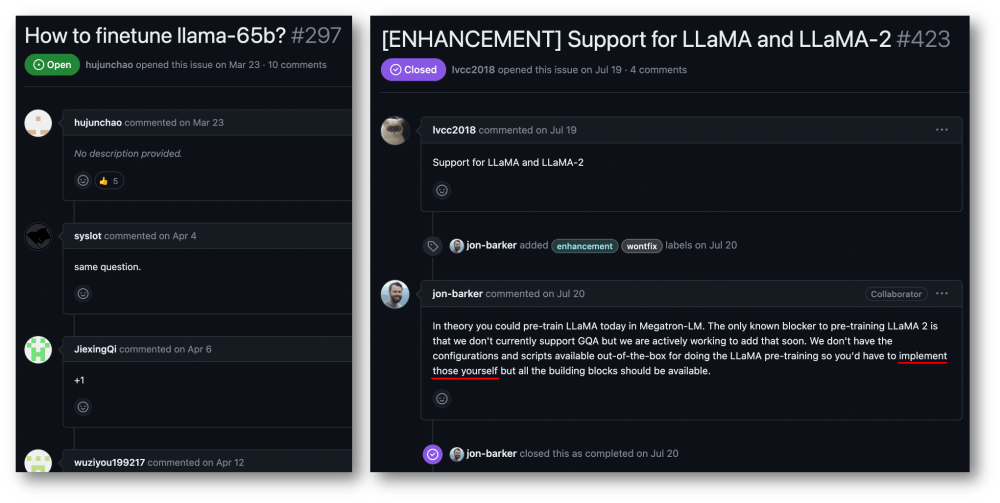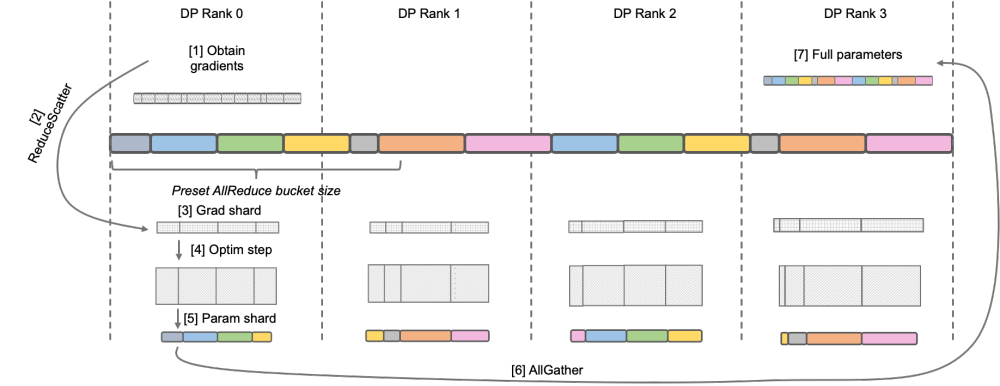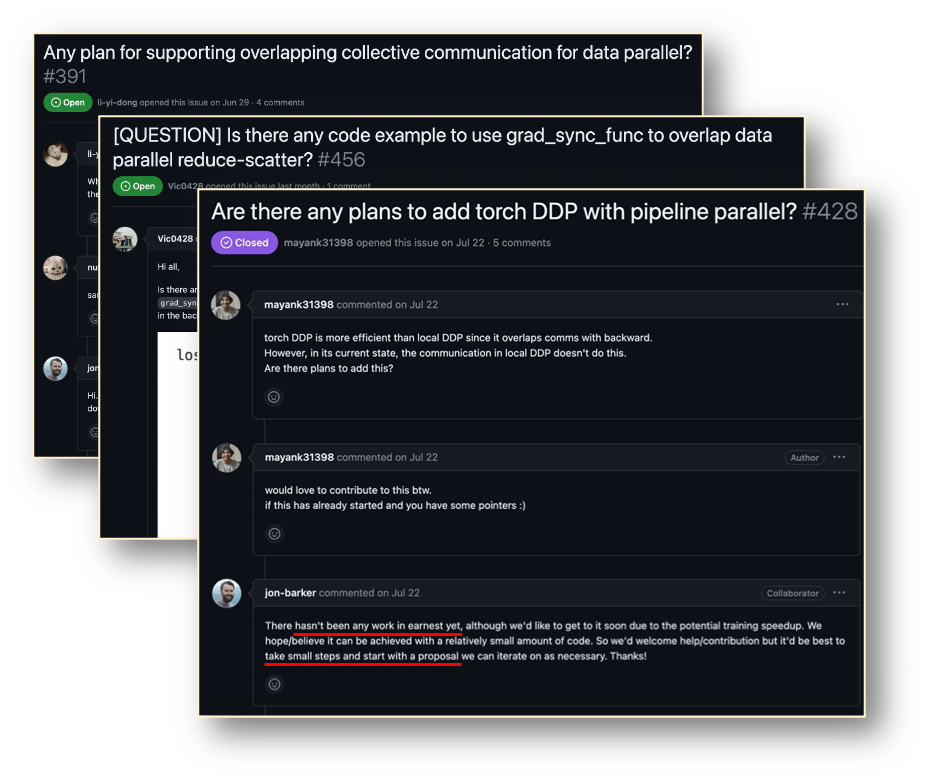
Taotian Group and Aicheng Technology officially released the open source large model training framework-Megatron-LLaMA on September 12. The goal of this framework is to make it easier for technology developers to improve the training performance of large language models, reduce training costs, and maintain compatibility with the LLaMA community. The test results show that on 32-card training, Megatron-LLaMA can achieve 176% acceleration compared with the code version obtained directly on HuggingFace; on large-scale training, Megatron-LLaMA expands almost linearly and is unstable to the network. Show a high level of tolerance. Currently, Megatron-LLaMA has been launched in the open source community
Open source address: https://github.com/alibaba/Megatron-LLaMA
The superior performance of large language models has exceeded people's imagination time and time again. Over the past few months, LLaMA and LLaMA2 have been made generally available to the open source community, providing a great option for those who want to train their own large language models. In the open source community, there are already many models developed based on LLaMA, including continued training/SFT (such as Alpaca, Vicuna, WizardLM, Platypus, StableBegula, Orca, OpenBuddy, Linly, Ziya, etc.) and training from scratch (such as Baichuan, QWen , InternLM, OpenLLaMA) work. These works not only performed well on various objective evaluation lists of large model capabilities, but also demonstrated excellent performance in practical application scenarios such as long text understanding, long text generation, code writing, and mathematical solving. In addition, many interesting products have appeared in the industry, such as LLaMA combined with Whisper's voice chat robot, LLaMA combined with Stable Diffusion's painting software, and auxiliary consultation robots in the medical/legal field, etc.
Although the LLaMA model code can be obtained from HuggingFace, training an LLaMA model with your own data is not a low-cost and simple task for individual users or small and medium-sized organizations. The volume of large models and the scale of data make it impossible to complete effective training on ordinary computing resources, and computing power and cost have become serious bottlenecks. The users of the Megatron-LM community have very urgent demands in this regard.

Taotian Group and Aicheng Technology have very broad application scenarios for large model applications, and have done a lot of work on efficient training of large models. investment. The advent of LLaMA has given many companies, including Taotian Group and Aicheng Technology, a lot of inspiration in terms of data processing, model design, fine-tuning and reinforcement learning feedback adjustment, and has also helped achieve new breakthroughs in business application scenarios. . Therefore, in order to give back to the entire LLaMA open source community and promote the development of the Chinese pre-trained large model open source community, so that developers can more easily improve the training performance of large language models and reduce training costs, Taotian Group and Aicheng Technology will combine some internal Optimize the technology and open source it, release Megatron-LLaMA, and look forward to building the Megatron and LLaMA ecosystem with every partner.
Megatron-LLaMA provides a set of standard Megatron-LM implementations of LLaMA, and provides and HuggingFace free formats The switching tool is convenient for compatibility with community ecological tools. Megatron-LLaMA has redesigned the reverse process of Megatron-LM, so that it can be achieved no matter where the number of nodes is small and large gradient aggregation (GA) needs to be turned on, or when the number of nodes is large and small GA must be used. Excellent training performance.
LLaMA is currently a large language model open source community Important work. LLaMA introduces optimization technologies such as BPE character encoding, RoPE position encoding, SwiGLU activation function, RMSNorm regularization and Untied Embedding into the structure of LLM, and has achieved excellent results in many objective and subjective evaluations. LLaMA provides 7B, 13B, 30B, 65B/70B versions, which are suitable for various large model demand scenarios and are also favored by the majority of developers. Like many other open source large models, since the official only provides the inference version of the code, there is no standard paradigm for how to carry out efficient training at the lowest cost
Megatron-LM is a Elegant high-performance training solution. Megatron-LM provides tensor parallelism (Tensor Parallel, TP, which allocates large multiplications to multiple cards for parallel computing), pipeline parallelism (Pipeline Parallel, PP, which allocates different layers of the model to different cards for processing), and sequence parallelism (Sequence Parallel, SP, different parts of the sequence are processed by different cards, saving video memory), DistributedOptimizer optimization (similar to DeepSpeed Zero Stage-2, splitting gradients and optimizer parameters to all computing nodes) and other technologies can significantly reduce video memory usage and improve GPU Utilization. Megatron-LM operates an active open source community, and new optimization technologies and functional designs continue to be incorporated into the framework.
However, developing based on Megatron-LM is not simple, especially debugging and functional verification on expensive multi-card machines is very expensive. Megatron-LLaMA first provides a set of LLaMA training code based on the Megatron-LM framework, which supports model versions of various sizes and can be easily adapted to support various variants of LLaMA, including Tokenizer that directly supports the HuggingFace format. Therefore, Megatron-LLaMA can be easily applied to existing offline training links without excessive adaptation. In small and medium-scale training/fine-tuning scenarios of LLaMA-7b and LLaMA-13b, Megatron-LLaMA can easily achieve an industry-leading hardware utilization (MFU) of more than 54%

The content that needs to be rewritten is: Illustration: DeepSpeed ZeRO Stage-2
DeepSpeed ZeRO is a set of distributed training frameworks launched by Microsoft. The technology proposed in it has had a profound impact on many subsequent frameworks. DeepSpeed ZeRO Stage-2 (hereinafter referred to as ZeRO-2) is a technology in the framework that saves memory usage without adding additional calculation and communication workload. As shown in the figure above, due to calculation requirements, each Rank needs to have all parameters. But for the optimizer state, each Rank is only responsible for a part of it, and it is not necessary for all Ranks to perform completely repeated operations at the same time. Therefore, ZeRO-2 proposes to evenly divide the optimizer state into each Rank (note that there is no need to ensure that each variable is evenly divided or completely retained in a certain Rank). Each Rank only needs to be used during the training process. Responsible for updating the optimizer status and model parameters of the corresponding part. In this setting, gradients can also be split in this way. By default, ZeRO-2 uses the Reduce method to aggregate gradients among all Ranks in reverse, and then each Rank only needs to retain the part of the parameters it is responsible for, which not only eliminates redundant repeated calculations, but also reduces the memory usage. .

Native Megatron-LM implements ZeRO-2-like gradient and optimizer state segmentation through DistributedOptimizer to reduce video memory usage during training. As shown in the figure above, DistributedOptimizer uses the ReduceScatter operator to distribute all the previously accumulated gradients to different Ranks after obtaining all the gradients aggregated by the preset gradient. Each Rank only obtains part of the gradient that it needs to process, and then updates the optimizer state and the corresponding parameters. Finally, each Rank obtains updated parameters from other nodes through AllGather, and finally obtains all parameters. The actual training results show that the gradient and parameter communication of Megatron-LM are performed in series with other calculations. For large-scale pre-training tasks, in order to ensure that the total batch data size remains unchanged, it is usually impossible to open a larger GA. Therefore, the proportion of communication will increase with the increase of machines. At this time, the characteristics of serial communication lead to very weak scalability. Within the community, this need is also urgent

In order to solve For this problem, Megatron-LLaMA has improved the DistributedOptimizer of the native Megatron-LM so that its gradient communication operator can be parallelized with the calculation. In particular, compared to ZeRO's implementation, Megatron-LLaMA uses a more scalable collective communication method to improve scalability through clever optimization of the optimizer partitioning strategy under the premise of parallelism. The main design of OverlappedDistributedOptimizer ensures the following points: a) The data volume of a single set communication operator is large enough to fully utilize the communication bandwidth; b) The amount of communication data required by the new segmentation method should be equal to the minimum communication data volume required for data parallelism; c) During the conversion process of complete parameters or gradients and segmented parameters or gradients, too many video memory copies cannot be introduced.

Specifically, Megatron-LLaMA has improved DistributedOptimizer and proposed OverlappedDistributedOptimizer, which is used to combine new ones in the reverse process of training. Optimize the segmentation method. As shown in the figure, when initializing OverlappedDistributedOptimizer, all parameters will be pre-allocated to the Bucket to which they belong. The parameters in each Bucket are complete. A parameter only belongs to one Bucket. There may be multiple parameters in a Bucket. Logically, each Bucket will be continuously divided into P parts (P is the number of data parallel groups), and each Rank in the data parallel group will be responsible for one of them
Buckets are placed in the local gradient bucket queue to ensure communication order. While training calculations are being performed, the data parallel groups exchange their required gradients in bucket units through collective communication. In Megatron-LLaMA, the Bucket implementation uses address indexing as much as possible, and new space is allocated only when the value needs to be changed to avoid wasting video memory
By combining a large number of Engineering optimization, the above design enables Megatron-LLaMA to make full use of hardware during large-scale training and achieve better acceleration than the native Megatron-LM. In a commonly used network environment, by expanding the training scale from 32 A100 cards to 512 A100 cards, Megatron-LLaMA can still achieve an expansion ratio of 0.85
Megatron-LLaMA is a training framework jointly open sourced by Taotian Group and Aicheng Technology and provided with follow-up maintenance support. It has been widely used internally. As more and more developers join LLaMA's open source community and contribute experiences that can be learned from each other, I believe there will be more challenges and opportunities at the training framework level in the future. Megatron-LLaMA will pay close attention to the development of the community and work with developers to promote the development in the following directions:
Project address: https://github.com/alibaba/Megatron-LLaMA
The above is the detailed content of 32-card 176% training acceleration, open source large model training framework Megatron-LLaMA is here. For more information, please follow other related articles on the PHP Chinese website!
 What skills are needed to work in the PHP industry?
What skills are needed to work in the PHP industry?
 How to check if mysql password is forgotten
How to check if mysql password is forgotten
 The difference between random and pseudo-random
The difference between random and pseudo-random
 The meaning of title in HTML
The meaning of title in HTML
 Solution to missing xlive.dll
Solution to missing xlive.dll
 Introduction to the method of intercepting strings in js
Introduction to the method of intercepting strings in js
 Why can't win11 be installed?
Why can't win11 be installed?
 How to solve access denied
How to solve access denied




